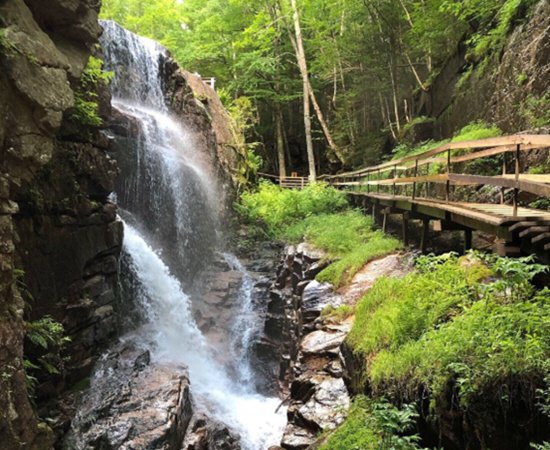The Flume Gorge
The Flume is a natural gorge extending 800 feet at the base of Mount Liberty.
The walls of Conway granite rise to a height of 70 to 90 feet and are 12 to 20 feet apart.
A trip into the Flume begins and ends at the Flume Visitor’s Center. Guests can choose to walk through just the Gorge or do a two-mile loop.

How Long Does It Take?
It takes about two hours. You can also walk the Flume Gorge and then take a shuttle back to the visitor center.
It is not handicap accessible.
It is not a hard hike but there are places where you have to climb stairs.
It is worth it!
How Much Does It Cost?
Adults: $16
Children (6-12): $14
Ages 5 and under: Free
Can You Swim at Flume Gorge?
Swimming is not allowed.
there are some very nice places in the area where you can swim but the Flume Gorge is too dangerous to allow swimming.
How Was the Flume Gorge Made?
Nearly 200 million years ago in Jurassic times, the Conway granite that forms the walls of the Flume was deeply buried molten rock.
As it cooled, the granite was broken by closely spaced vertical fractures which lay nearly parallel in a northeasterly direction. Sometime after the fractures were formed, small dikes of basalt were forced up along the fractures. The basalt came from deep within the earth as a fluid material, and because of pressure, was able to force the Conway granite aside.
The basalt crystallized quickly against the relatively cold granite. Because of this quick cooling, the basalt is a fine-grained rock. Had this material ever reached the surface, it would have become lava flows.
Erosion gradually lowered the earth’s surface and exposed the dikes. As the overlying rock was worn away, the pressure was relieved and horizontal cracks developed, allowing water to get into the rock layers. The basalt dikes eroded faster than the surrounding Conway granite, creating a deepening valley where the Flume Gorge is now.
The gorge was covered by glaciers during the Ice Age, but the ice sheet did not greatly change the surface. It partially filled the valley with glacial debris and removed soil and weathered rock from the vicinity. After the Ice Age, Flume Brook began to flow through the valley again.
The highly fractured granite and basalt have been eroded by frost action as well as by the brook’s water. As you walk through the Flume, look at the floor of the Gorge and you many notice remnants of the main basalt dike, and on the walls of the gorge, small trees are growing.
Erosion is still occurring.
Is the Flume Gorge Open in the Winter?
Official operating dates: May 10 – October 20
The Flume Gorge may also be closed due to inclement weather.
What Town Is the Flume Gorge In?
Franconia, New Hampshire
Is the Flume Gorge Handicap Accessible?
The trails and the Flume Gorge are very difficult, with a number of stairs, narrow walkways, roots, and rocks. The Flume Gorge is not recommended, for individuals with mobility impairments.
Are Dogs Allowed?
Pets are not permitted in the Flume Gorge and Visitor Center.
Pets are only permitted in Franconia Notch State Park in the designated dog walks in the Flume & Tramway parking lots.
Who Discovered the Flume Gorge?
The Flume was discovered in 1808 by 93-year-old “Aunt” Jess Guernsey when she accidentally came upon it while fishing.
She had trouble convincing her family of the marvelous discovery, but eventually persuaded others to come and see for themselves.
At that time, a huge, egg-shaped boulder hung suspended between the walls. The rock was 10 ft (3.0 m) high and 12 ft (3.7 m) long. A heavy rainstorm in June 1883 started a landslide that swept the boulder from its place. The boulder has never been found.
The same storm deepened the gorge and formed Avalanche Falls.
A short video (1:40) showcasing the Flume Gorge.
